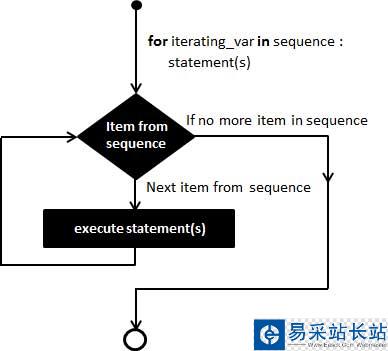下面的代码中python2与python3的print使用区别,大家注意一下。python3需要加()才行。
语法:
for循环的语法格式如下:
for iterating_var in sequence: statements(s)
流程图:

实例:
#!/usr/bin/python# -*- coding: UTF-8 -*- for letter in 'jb51.net': # 第一个实例 print '当前字母 :', letter fruits = ['banana', 'apple', 'mango','orange']for fruit in fruits: # 第二个实例 print '当前水果 :', fruit print "Good bye!"
以上实例输出结果:
当前字母 : j当前字母 : b当前字母 : 5当前字母 : 1当前字母 : .当前字母 : n当前字母 : e当前字母 : t当前水果 : banana当前水果 : apple当前水果 : mango当前水果 : orangeGood bye!
通过序列索引迭代
另外一种执行循环的遍历方式是通过索引,如下实例:
#!/usr/bin/python# -*- coding: UTF-8 -*- fruits = ['banana', 'apple', 'mango']for index in range(len(fruits)): print '当前水果 :', fruits[index] print "Good bye!"
以上实例输出结果:
当前水果 : banana
当前水果 : apple
当前水果 : mango
Good bye!
以上实例我们使用了内置函数 len() 和 range(),函数 len() 返回列表的长度,即元素的个数。 range返回一个序列的数。
循环使用 else 语句
在 python 中,for … else 表示这样的意思,for 中的语句和普通的没有区别,else 中的语句会在循环正常执行完(即 for 不是通过 break 跳出而中断的)的情况下执行,while … else 也是一样。
#!/usr/bin/python# -*- coding: UTF-8 -*- for num in range(10,20): # 迭代 10 到 20 之间的数字 for i in range(2,num): # 根据因子迭代 if num%i == 0: # 确定第一个因子 j=num/i # 计算第二个因子 print '%d 等于 %d * %d' % (num,i,j) break # 跳出当前循环 else: # 循环的 else 部分 print num, '是一个质数'
以上实例输出结果:
10 等于 2 * 511 是一个质数12 等于 2 * 613 是一个质数14 等于 2 * 715 等于 3 * 516 等于 2 * 817 是一个质数18 等于 2 * 919 是一个质数
以下是一些实例
for 使用案例
使用list.append()模块对质数进行输出。
#!/usr/bin/python# -*- coding: UTF-8 -*-# 输出 2 到 100 简的质数prime = []for num in range(2,100): # 迭代 2 到 100 之间的数字 for i in range(2,num): # 根据因子迭代 if num%i == 0: # 确定第一个因子 break # 跳出当前循环 else: # 循环的 else 部分 prime.append(num)print prime
输出结果:
[2, 3, 5, 7, 11, 13, 17, 19, 23, 29, 31, 37, 41, 43, 47, 53, 59, 61, 67, 71, 73, 79, 83, 89, 97]
新闻热点
疑难解答